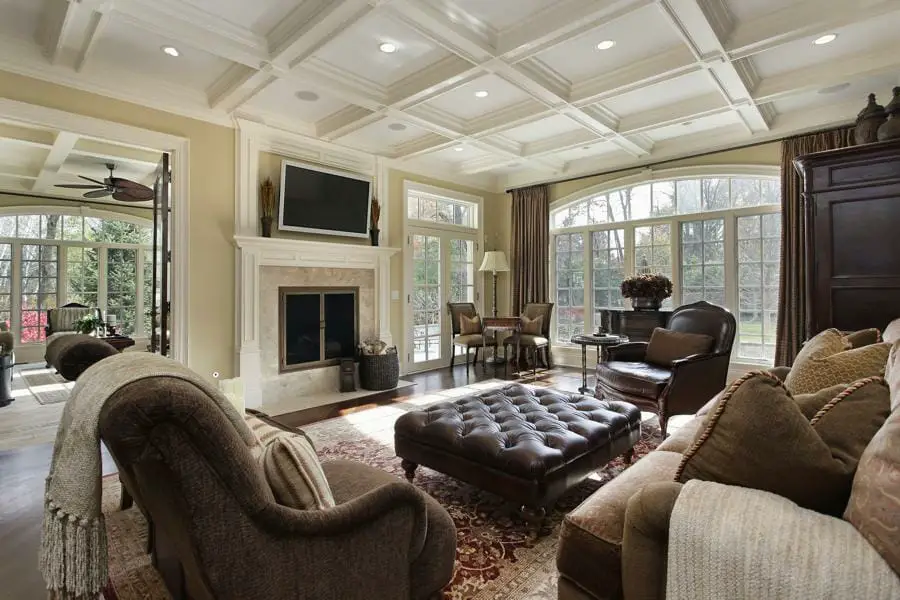Large rooms are a delight, a place where the whole family can be together in plenty of space. However, air purification is a problem because of the volume of air that needs to be processed. So many air purifiers are not suitable.
After much thought and data gathering here is my recommendation for a large room-
The best large room air purifier is the Coway 400S, it has a highly specified filter for removing ultrafine particles and a very high airflow at a lower noise level than any other consumer air purifier. So it is ideally suited to a large room. The Sharp FX-J80U is a great alternative.
How do we work out which air purifier is best and if there is a cheaper alternative than these 2 excellent but mid to upper range machines?

The recomendations in this article are carefully selected and use information which other websites do not have-
The Problem of Air Purifier Noise
Let me explain, no one will want to be in the room for long periods with the air purifier on maximum fan speed, it is simply too stressful. So what I want to avoid is you buying a machine that will only cope with your room size but only when the machine is on a setting that makes too much noise.
So we need to know how much noise the air purifiers make on all its different fan speeds. Unfortunately, about 50% of manufacturers will not tell us, they only give noise data for maximum fan speed. The data for lower speeds is not on the website or in the manuals and repeated emails to customer service even asking them to contact technical support invariably comes back with “we do not have that information”. On their website one manufacturer only gives a noise level for the lowest airflow! On further investigation for this air purifier, this airflow would be only enough for a large closet.
Sometimes the data is unbelievable as it is the same as another model of that manufacturers range which as the machines are physically different, so there is probably a mistake. Then when you point this out to customer services and ask them to check there is no response. Some manufacturers do not even give an air flow/clean air delivery rate! This leaves you thinking, why not?
So what should you do? Do you buy an air purifier from an internet review without the information and hope it is not too loud, if it is you will need to return it? Even if it is not too loud without the airflow data at lower fan speeds you do not know whether the airflow is high enough for your room, so as you do not want your health to deteriorate unnecessarily you need to check the air quality. This means buying an air quality sensor.
Alternatively, you could buy one of my recommendations. I have done the investigation for you and know exactly what the air flows and noise levels are for the air purifiers that I recommend. So if a manufacturer will not give the data to consumers which is essential for making a good choice, I feel the right thing to do is not to recommend their air purifiers to avoid consumers making bad purchases. I also sometimes check their noise measurements. I never recommend an air purifier for long-term use for a certain room area, that has a specified or checked noise level of greater than 50db.
Please note that you may be more noise tolerant than me or will be sitting a long distance from the air purifier, then you unnecessarily maybe buy a noisier one. 50db some customer service reps will tell you is the sound of a fridge, I don’t know where they get their fridges from”
Most air purifiers will cope with rooms up to about 200 sq ft (assuming the room has 8 ft ceilings) at a reasonable noise level. Beyond this we need to tread carefully as very few machines cope well without excessive noise.
For a Large Room is the Quality of the Filtration or the Air Flow Through the Air Purifier the Deciding Factor?
Let me explain. Basically an air purifier has a fan which sucks in air and then pushes it through the filter where the airborne particles are then trapped. The trapped particles are permanently removed from the air so improving indoor air quality. So the most important features of an air purifier are the quality of the filter and the amount of air that the fan is pushing through it every minute. But which is most important for a large room?
1) True HEPA Filters-are very similar in their effectiveness in removing fine particles but do differ in specifications for removing ultrafine particles
The most damaging aspect of poor quality air on health is usually due to the effect of particles. So a crucial feature of any air purifier is the particle filter as this determines the highest purification that the air purifier can achieve. HEPA filtration is extremely efficient and now effectively the minimum standard for a filter. Therefore, it is important to have a true HEPA filter-this will effectively remove almost all airborne particles. Beware of “HEPA like”, “HEPA style” “99% HEPA”… terms describing the filter like this means it is not a true HEPA filter.
The HEPA specification is based on the ability to remove fine particles 0.1um-10um. The standard specifies that the filter must remove 99.97% of particles of 0.3um in diameter.
So ultrafine airborne particles which are less than 0.1um and so not explicitly covered in the HEPA specification but they are also major health concern. These particles have been found in the bloodstreams of humans and are thought to be very important in the damage to human health from pollution, as outlined in this article. Some air purifier manufacturers are now specifying the range of ultrafine particles that their HEPA filter will remove. My top pick, the Coway 400S is certified to remove 99.95% particles down to 0.01um.
This is a filter specification that separates the Coway 400S from all others on the market except the iQair HealthPro Plus.
So having established that a HEPA air purifier is essential but does not decide which air cleaner to choose amongst the 100 or more models with a HEPA filter, let’s now turn to the factor which does decide-airflow.
2) Airflow-the deciding factor in choosing the best air purifier for a large room
The amount of air purified per minute needs to be higher for larger spaces. So in choosing the best large room air purifier the airflow that the air purifier can achieve at reasonable noise levels is extremely important.
There are manufacturer’s claims then repeated in internet reviews that consumer air purifiers (less than $1000) can service an area larger than 650sq ft. It is true that you can simply switch any air purifier on in a big room and it will slightly purify the air. However, the air purification will be substandard, you may only get a 20 or 30% particle reduction rather than the minimum EPA stipulated 80% reduction. Unfortunately, this may then lead to lower quality health outcomes for you and your family, as outlined in this article.
There is no consumer air purifier on the market that can purify the air of a larger space than 650 sq ft (assuming 8 ft ceilings) with a noise output of 50db or lower, and meet the EPA’s minimum standard for air purification.
The EPA’s minimum standard for purifying air is that the air purifier should provide 4.9 air changes per hour. An air change is when a volume of air equal to the volume of the room has gone through the air purifier once. So at a minimum all the air in your room should go through the air purifier 4.9 times every hour. This will reduce the particle count in the air by 80%.

The only way of purifying the air in an area greater than 650 sq ft is to have multiple air purifiers.
Do not judge an air purifier by its looks some of the best looking air purifiers have surprisingly low airflows. Neither is the robustness of construction a guide, there are robust air purifiers on the market that have very low airflows.
Also, please do not judge by how expensive an air purifier is. Some very expensive air purifiers have no clean air delivery rate (CADR) specified at all. This may make you wonder why a manufacturer would not specify the CADR, you may think that they would do so if the CADR was good. It also makes it impossible for you to size the air purifier according to the EPA’s room sizing guidance.
My advice is if the air purifier manufacturer will not give you the CADR at the fan rate where the noise is slightly below 50db then do not buy that air cleaner. The reason is that if you buy one for its highest flow rate which is often noisier than 50db, you are likely to switch it down to a quieter fan setting.
On this quieter setting, you will get inadequate air purification as you sized the air purifier for your room using the highest setting, You may only achieve a 50% reduction in particle count. The inadequate reduction in particle count will mean that your health will deteriorate at a faster rate, and this will occur without you realising it until something goes wrong.
If you do measure the particle count with a meter as I encourage everyone to do, you will realise that the particle reduction is inadequate and that you need to buy another different air purifier.
So please before you buy any air purifier check that the manufacturer gives you a CADR at a noise level less than 50db, if not, do not buy that air purifier.
So the new airflow technology that separates the Coway 400S from other air purifiers is the design, with one set of filters on either side of the machine. This allows a larger filter surface area, less resistance to airflow and so a larger airflow for a lower noise.
Particles are not the only airborne pollutant affecting large rooms, chemicals can also build up in our homes especially as they become more sealed with new building techniques.
Other Factors Also Help Narrow Down the Choice
1) Removal of Chemicals From the Air-a good activated carbon filter is needed in any air purifier
In any room ventilation can be suboptimal and so an air purifier for any room, including a large room, should have a method of removing chemicals. The generally accepted way of doing this is with an activated carbon filter.
Most modern air purifiers have activated carbon filters the best ones have granular activated charcoal filters. Granules of solid activated carbon provide a very large surface area in cracks inside the granules as seen in this filter-
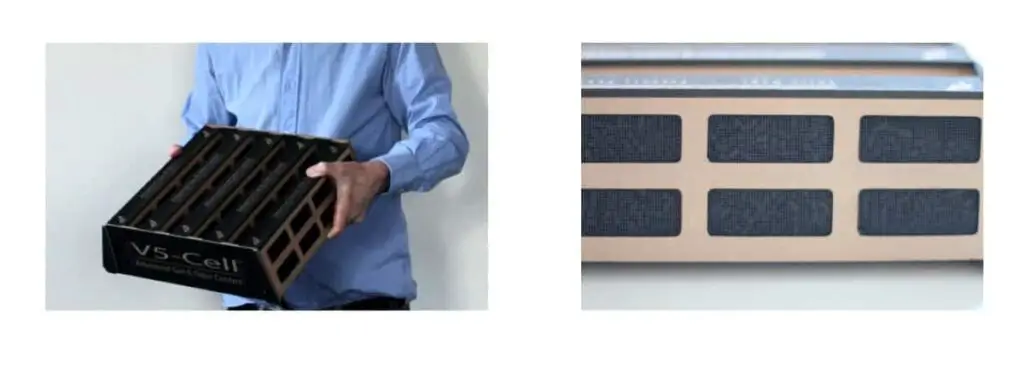
For other carbon filters, a thin layer of carbon is applied to the surface of the filter. Activated carbon filters remove volatile organic compounds by adsorption. The weight of carbon determining their capacity to remove chemicals. The carbon filters are sometimes impregnated with chemicals to use chemisorption as well to remove chemicals. Chemisorption works by a compound in the filter forming a molecular bond with the air pollutant. The chemical filters make the air safer and also lessen any odors. The Coway 400S has 2 granular carbon filters.
As with particles the chemicals stuck to the filter are thrown away when the old filter is discarded and a replacement filter installed in the air purifier. In this way the chemicals are permanently removed from the room.
Please note a carbon filter can remove many things but not radio-isotopes. So radon levels which can be high in some homes and are linked to lung cancer will not be reduced by an air purifier.
2) Smart Control-essential for any air purifier
This narrows down the choice by excluding all air purifiers without WIFI or the ability to be controlled by a smart plug. Owning 8 air purifiers of 5 different brands I have found having a smart air purifier or at least one that can be made smart with a smart plug is essential.
The reason for needing a smart air purifier is because an air purifier takes 30-45 minutes to reduce the particle count in the air. So if you do not have an air purifier that will come on 30 minutes before you enter the room you will need to enter the room, switch it on then leave the room again and return 45 minutes later. Or you will stay in the room and breathe air with too high a particle count for 45 minutes. During this time more particles will be deposited in your lungs and enter your bloodstream than if you had had a smart air purifier which had switched itself on before you entered the room.
The Top Air Purifiers for Large Room
The choices here represent the best choices of air purifiers from all established manufactures on the market who would give me the noise levels at their machines various air flows. This information is needed so that I do not recommend an air purifier that is too noisy for you. Also, as outlined above only air purifiers with smart control were considered for health reasons.
Coway 400S
This is my pick as the best large room air purifier because of its superb filter and high airflow a the lowest possible noise levels for the airflow.
Specifications
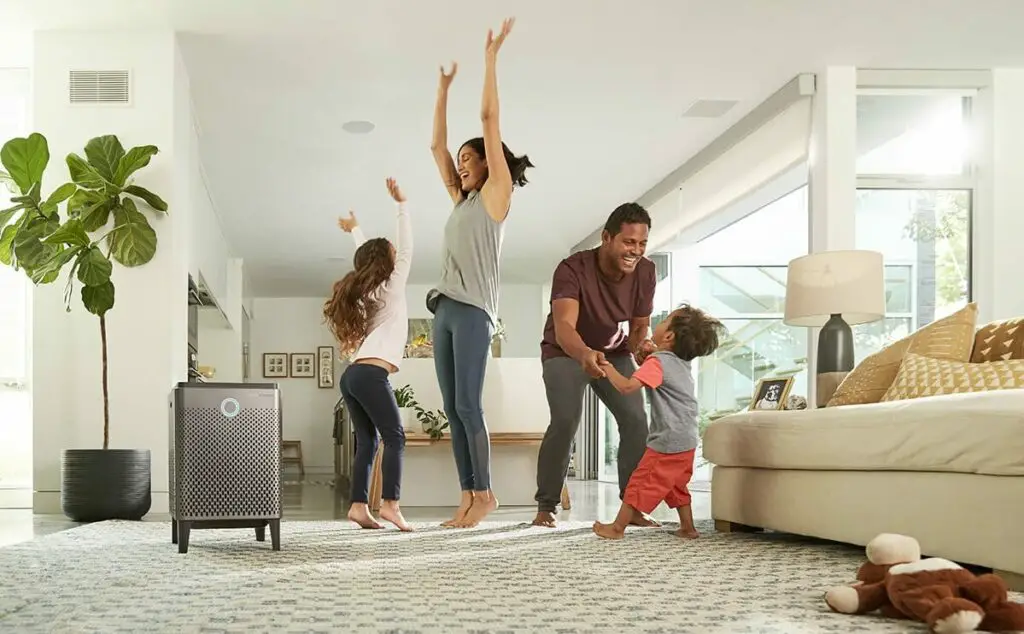
| Filters | |
| HEPA filter | HEPA specified to remove 99.8% of ultrafine particles down to a size of 0.01um |
| Carbon filter amount of carbon (lb) | 1.5 lb so more than most other air purifiers |
| Filter Change HEPA (Particles) | 12 months |
| Filter Change Carbon (Chemicals) | 12 months |
| Airflow | |
| CADR at =<50db (CADR on Maximum) | |
| Maximum Room Size (Noise less than 50db*) | 450 sq ft |
| Maximum Room Size (On noisiest setting) | 640 sq ft |
| Smart Control | Yes phone app |
| Power | 66 W |
| Weight | 24.7 lbs |
| Dimensions “H x “W x D” | 22.8 x 14.8 x 14.8 |
| Annual Running Cost Electricity ($) | $40 |
| Annual Running Cost Filters ($) | $120 |
| Total Annual Running Cost ($) | $160 |
All the above are approximate and assume running the air purifier for 12 hours per day on the highest setting that keeps the noise below the level specified in db in the table. This is less than or equal to 50db in normal daytime use and 35db for bedrooms.
*Most people will not wish to have the air purifier on a setting louder than about 35db for sleeping in a bedroom-you may wish to have a quieter setting than 35db this is just a ballpark estimate for most people. On the other hand, if your room layout allows you to be much further than 6 feet from the air purifier you may find the noise this machine makes at top speed is alright. The calculations for room size assume that you have 8 foot ceilings and 5 air changes per hour.
Never run an air purifier on auto mode using the inbuilt sensor. These cannot detect ultrafine particles which are damaging to human health, please see this article- How to test the air quality in your home.
Sharp FX-J80U
Also an excellent choice for a large room with an airflow capability similar to the Coway 200S.
Specifications
| Filters | |
| HEPA filter | Yes |
| Carbon filter amount of carbon | Carbon granules about 1lb |
| Filter Change HEPA (Particles) | 24 months “maximum life” |
| Filter Change Carbon (Chemicals) | 24 months “maximum life” |
| Airflow | |
| CADR at =<50db (CADR on Maximum) | 321 cfm |
| Maximum Room Size (Noise less than 50db*) | 494 sq ft |
| Maximum Room Size (On noisiest setting) | 494 sq ft |
| Smart Control | Yes phone app, Alexa or smart home system with a smart plug |
| Power | 70 W |
| Weight | 23.8 lb |
| Dimensions “H x “W x D” | 28.7 x 16.4 x 11.5 inches |
| Annual Running Cost Electricity | $42 |
| Annual Running Cost Filters | $90 |
| Total Annual Running Cost | $130 |
Multiple Levoit 200S each only $80 and 3 of these could cover an area of 540 sq ft
This air purifier has the highest airflow per dollar of any air purifier on the market from a well known manufacturer, approximately double that of other air purifiers.
There is always an argument in a large room for rather than having one big air purifier at one end of the room having 2 smaller ones at either end of the room. This is because the mixing of air in a room is not perfect, so with one large air purifier down one end of the room the air at the other end will not get as much purification.
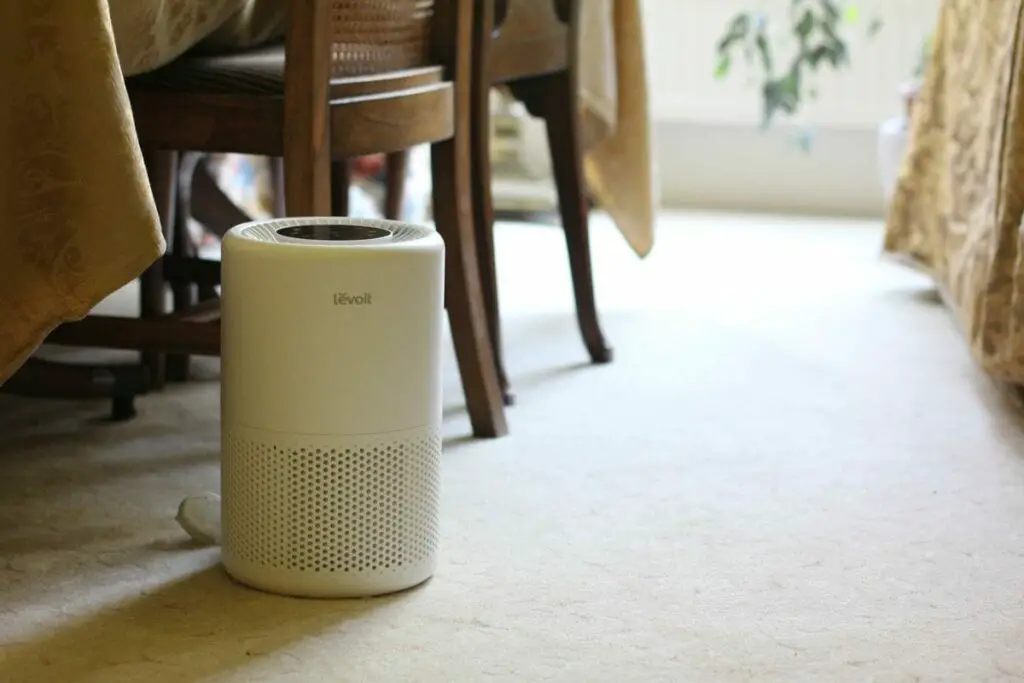
Specifications
| Filters | |
| HEPA filter | HEPA 13 filter |
| Carbon filter amount of carbon | Small amount of carbon incorporated into main filter 0.1 lb |
| Filter Change HEPA (Particles) | 7 months |
| Filter Change Carbon (Chemicals) | 7 months |
| Airflow | |
| CADR at =<50db (CADR on Maximum) | 118 cfm (118 cfm) |
| Maximum Room Size (Noise less than 50db*) | 183 sq ft |
| Maximum Room Size (On noisiest setting) | 183 sq ft |
| Smart Control | Smart Phone App/Alexa/Google Home |
| Power | 37 W |
| Weight | 6.6 lb |
| Dimensions “H x “W x D” | 12.6 x 8.1 x 8.1inches |
| Annual Running Cost Electricity | $24 |
| Annual Running Cost Filters | $45 |
| Total Annual Running Cost | $70 |
iQair HealthPro Plus-Best Air Purifier on the Market but Not so Suitable For Large Rooms
The above air purifiers are extremely well suited to large rooms. However, the best air purifier on the market is the IQ air HealthPro plus. This is not so well suited to large rooms because it will only service as an area of 262 sq ft at a noise of 50 dB. I find constant noises above this too intrusive, you may of course be different or have a long thin large room where the air purifier will be at the other end of the room, in which case the HealthPro plus would be an excellent choice for your room. I have written an article about it here.
How Long Should I Run an Air Purifier for in a Large Room?
As a general rule you should run the air purifier for 30-45 minutes before going into the room and then continuously whilst you are in the room. This is the standard technique for using an air purifier in any room, you may be interested in this article which goes into more detail about how to use an air purifier.
All Other Air Purification Technologies Have Problems
HEPA air purification with an activated carbon filter and a fan to push air through the filters is the standard method of air purification. There are other techniques but they have problems compared to this standard-
- PECO eg the Molekule-not effective enough at reducing particles see Wirecutter YouTube video.
- UV light-ineffective at dealing with some microorganisms (please see this article), potential for eye damage and ozone production depending on technology used. They do not remove particles.
- Ionising air purifiers give particles an electric charge which makes them stick to things. They can reduce particles count in the air but increase the depositing of particles in your lungs. This technology does not deal with chemicals. Further details of how ionizing air purifiers work can be found here.
- PCO-photocatalytic oxidation-uses UV light and titanium oxide to change particles. It does not remove airborne particles such as mold spores, allergen, house dust mite, pet dander, house dust particles, or cigarette smoke particles. It can produce formaldehyde which is carcinogenic.
- Ozone generators-damaging for health in any case and like PCO and UV light do not remove particles.
Other Important Ways to Improve Indoor Air Quality
- Install some form of ventilation and periodically ventilate the room. This is the only way to reduce the concentration of radio-isotopes eg Radon.
- Use a robotic HEPA vacuum cleaner to clean the floor of dust regularly.
- Regularly dust the room, ideally just before vacuuming.
Conclusion-the best large room air purifier
The best air purifier for a large room is the Coway 400S it has the highest airflow delivery for the lowest noise of any consumer air purifier.
The best air purifier for a large room is the Coway 400S it has the highest airflow delivery for the lowest noise of any consumer air purifier. The Sharp FX-J80U would also be an excellent choice there is little to choose between these two air purifiers. Either will improve the air quality in your room so that your health does not suffer.
You will see many great-looking air purifiers with all sorts of technologies, but they will not in reality be as good as these 2 air purifiers. Many will not even be even half as good even although they are more expensive and look wonderful. So if you decide to buy anything else tread carefully, there are plenty of machines out there with hidden drawbacks.
If you cannot really afford these machines, your choice is easy, the Levoit 200S delivers more cubic feet of air per minute per dollar than any other machine from a reputable manufacturer. It delivers twice as much purified air per dollar as most other machines. It will only serve an area of 183 sq ft so if your room is larger you may need 2 or more of these air purifiers.
Related Questions
Related Posts
How air purifiers work-a fascinating article explaining the mechanisms in an air purifier that make them work.
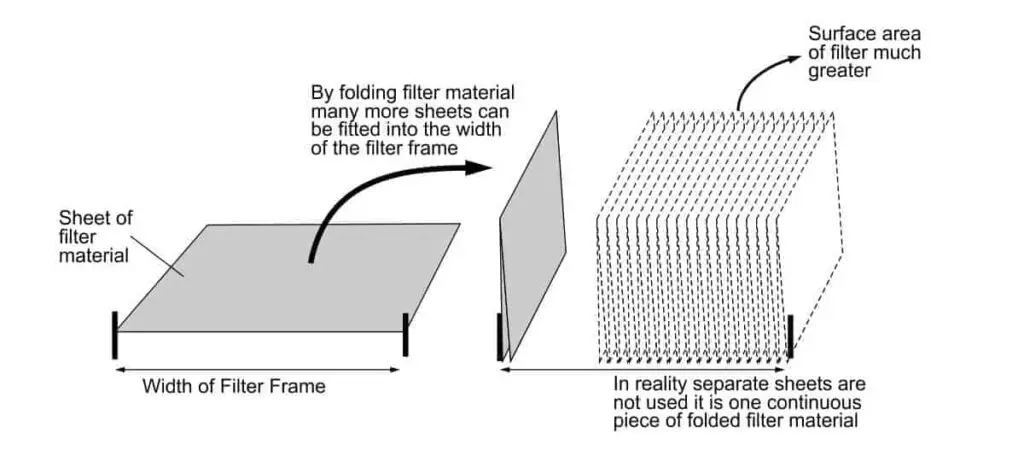
The health effects of particles in the air-a very important article to read about the effect of particles in the air on our health with some surprising facts.

The best air purifier for smoke-an important article about the nature of smoke, both forest fire and cigarette smoke. It outlines smokes nature and the best air purifiers to buy to combat it.


